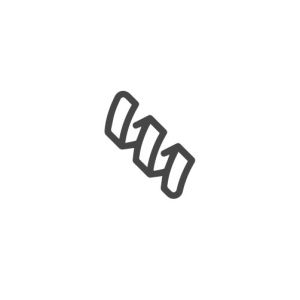Catalog No: OPCA00520
Price: $0.00
SKU
OPCA00520
Availability: Domestic: Antibody & Kits: 2 weeks | Proteins: 4-6 weeks | International: Antibody & Kits: 2 weeks | Proteins: 4-6 weeks
Contact Us:
- Toll Free: 888-880-0001
- Phone: 858-552-6979
- Email: info@avivasysbio.com
Shipping Info:
- $55: Antibody & Protein in US
- $55 + $25/Kit in US
- Contact us for international orders.
| Datasheets/Manuals | Printable datasheet for PARK7 Recombinant Protein (Human) (OPCA00520) (OPCA00520) |
|---|
| Predicted Species Reactivity | Homo sapiens|Human |
|---|---|
| Product Format | Liquid or Lyophilized powder |
| Additional Information | Tag information : GST tag |
| Reconstitution and Storage | -20°C or -80°C |
| Purity | Greater than 90% as determined by SDS-PAGE. |
| Peptide Sequence | MASKRALVILAKGAEEMETVIPVDVMRRAGIKVTVAGLAGKDPVQCSRDVVICPDASLEDAKKEGPYDVVVLPGGNLGAQNLSESAAVKEILKEQENRKGLIAAICAGPTALLAHEIGFGSKVTTHPLAKDKMMNGGHYTYSENRVEKDGLILTSRGPGTSFEFALAIVEALNGKEVAAQVKAPLVLK |
| Protein Sequence | MASKRALVILAKGAEEMETVIPVDVMRRAGIKVTVAGLAGKDPVQCSRDVVICPDASLEDAKKEGPYDVVVLPGGNLGAQNLSESAAVKEILKEQENRKGLIAAICAGPTALLAHEIGFGSKVTTHPLAKDKMMNGGHYTYSENRVEKDGLILTSRGPGTSFEFALAIVEALNGKEVAAQVKAPLVLK |
| Storage Buffer | If the delivery form is liquid, the default storage buffer is Tris/PBS-based buffer, 5%-50% glycerol. If the delivery form is lyophilized powder, the buffer before lyophilization is Tris/PBS-based buffer, 6% Trehalose, pH 8.0. |
| Source | E.coli |
| Protein Range | 1-188 aa |
| Tag | N-terminal GST-tagged |
| Reference | DJ-1, a novel oncogene which transforms mouse NIH3T3 cells in cooperation with ras.Nagakubo D., Taita T., Kitaura H., Ikeda M., Tamai K., Iguchi-Ariga S.M.M., Ariga H.Biochem. Biophys. Res. Commun. 231:509-513(1997) |
| Gene Symbol | PARK7 |
|---|---|
| Gene Full Name | Parkinsonism associated deglycase |
| Alias Symbols | DJ1;DJ-1;epididymis secretory sperm binding protein Li 67p;GATD2;HEL-S-67p;maillard deglycase;oncogene DJ1;Parkinson disease (autosomal recessive, early onset) 7;Parkinson disease protein 7;parkinson protein 7;Parkinsonism-associated deglycase;protein deglycase DJ-1;protein DJ-1;protein/nucleic acid deglycase DJ-1. |
| NCBI Gene Id | 11315 |
| Protein Name | Protein/nucleic acid deglycase DJ-1 |
| Description of Target | Protein and nucleotide deglycase that catalyzes the deglycation of the Maillard adducts formed between amino groups of proteins or nucleotides and reactive carbonyl groups of glyoxals (PubMed:25416785, PubMed:28596309). Thus, functions as a protein deglycase that repairs methylglyoxal- and glyoxal-glycated proteins, and releases repaired proteins and lactate or glycolate, respectively. Deglycates cysteine, arginine and lysine residues in proteins, and thus reactivates these proteins by reversing glycation by glyoxals. Acts on early glycation intermediates (hemithioacetals and aminocarbinols), preventing the formation of advanced glycation endproducts (AGE) that cause irreversible damage (PubMed:25416785, PubMed:28013050, PubMed:26995087). Also functions as a nucleotide deglycase able to repair glycated guanine in the free nucleotide pool (GTP, GDP, GMP, dGTP) and in DNA and RNA. Is thus involved in a major nucleotide repair system named guanine glycation repair (GG repair), dedicated to reversing methylglyoxal and glyoxal damage via nucleotide sanitization and direct nucleic acid repair (PubMed:28596309). Also displays an apparent glyoxalase activity that in fact reflects its deglycase activity (PubMed:22523093). Plays an important role in cell protection against oxidative stress and cell death acting as oxidative stress sensor and redox-sensitive chaperone and protease; functions probably related to its primary function (PubMed:17015834, PubMed:20304780, PubMed:18711745, PubMed:12796482, PubMed:19229105, PubMed:25416785, PubMed:26995087). It is involved in neuroprotective mechanisms like the stabilization of NFE2L2 and PINK1 proteins, male fertility as a positive regulator of androgen signaling pathway as well as cell growth and transformation through, for instance, the modulation of NF-kappa-B signaling pathway (PubMed:12612053, PubMed:15502874, PubMed:14749723, PubMed:17015834, PubMed:21097510, PubMed:18711745). Eliminates hydrogen peroxide and protects cells against hydrogen peroxide-induced cell death (PubMed:16390825). Required for correct mitochondrial morphology and function as well as for autophagy of dysfunctional mitochondria (PubMed:19229105, PubMed:16632486). Plays a role in regulating expression or stability of the mitochondrial uncoupling proteins SLC25A14 and SLC25A27 in dopaminergic neurons of the substantia nigra pars compacta and attenuates the oxidative stress induced by calcium entry into the neurons via L-type channels during pacemaking (PubMed:18711745). Regulates astrocyte inflammatory responses, may modulate lipid rafts-dependent endocytosis in astrocytes and neuronal cells (PubMed:23847046). In pancreatic islets, involved in the maintenance of mitochondrial reactive oxygen species (ROS) levels and glucose homeostasis in an age- and diet dependent manner. Protects pancreatic beta cells from cell death induced by inflammatory and cytotoxic setting (By similarity). Binds to a number of mRNAs containing multiple copies of GG or CC motifs and partially inhibits their translation but dissociates following oxidative stress (PubMed:18626009). Metal-binding protein able to bind copper as well as toxic mercury ions, enhances the cell protection mechanism against induced metal toxicity (PubMed:23792957). In macrophages, interacts with the NADPH oxidase subunit NCF1 to direct NADPH oxidase-dependent ROS production, and protects against sepsis (By similarity). |
| Uniprot ID | Q99497 |
| Protein Size (# AA) | Recombinant |
| Molecular Weight | 46.8 kDa |
- Protocol:
- Reconstitution & Storage Instructions
- Western Blotting/Immunoblotting (WB/IB) Protocol
- Immunohistochemistry (IHC) Protocol
- Immunocytochemistry (ICC) Protocol
- Enzyme-Linked ImmunoSorbent Assay (ELISA) Protocol
- Blocking Peptide Competition Protocol (BPCP)
- Immunoprecipitation (IP) Protocol
- Antibody Array (AA) Protocol
- Tips Information:
-
See our General FAQ page.
Write Your Own Review
We found other products you might like!






